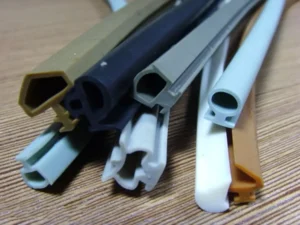Rubber sealing strips are widely used across industries—from automotive and construction to HVAC and household appliances. While material selection is crucial, the shape of a rubber seal plays a decisive role in its sealing performance, durability, and adaptability to various surfaces. This blog explores how different seal shapes affect compressibility, noise insulation, and application suitability.
🔍 Key Factors That Influence Rubber Seal Strip Performance
To ensure proper sealing and longevity, several aspects must be evaluated when selecting a rubber sealing strip:
- Seal Shape: Determines how well the strip conforms to surfaces and handles compression.
- Material Type: Common options include EPDM, silicone, and neoprene—each offering unique weather, UV, and chemical resistance.
- Environmental Conditions: High or low temperatures, UV exposure, and chemical agents can affect sealing performance.
- Installation Method: Adhesive-backed vs mechanical fastening may impact durability and ease of use.

🧩 Common Rubber Seal Strip Shapes & Their Applications
Different profiles suit different needs. Choosing the right one is critical for performance:
| Shape | Description | Common Applications |
| Flat | Simple profile for flat surfaces | Doors, cabinets |
| Round (Cord) | Excellent compressibility and flexibility | Pipes, tubes |
| D-shaped | Good for compression sealing | Car doors, windows |
| P-shaped / T-shaped | Multi-directional sealing | Garage doors, machinery |
| Custom Extrusion | Tailored to specific geometry | OEM applications |
💡 Why Shape Matters: Compressibility & Surface Fit
- Flat strips offer limited compressibility and are ideal for flat-to-flat surface contact.
- Round and D-shaped strips compress more evenly and conform to curves or uneven surfaces, ensuring a tighter seal.
- Complex extrusion profiles allow for multi-chamber or dual-material sealing, useful in demanding environments.

🔇 Noise Reduction Capabilities of Rubber Seals
Noise insulation is another important aspect in automotive and construction fields:
- Absorption: High-density rubber absorbs airborne sound waves.
- Barrier: A well-fitted seal blocks sound transmission.
- Resilience: Strong rebound helps maintain tight sealing and continuous noise blocking.
✅ How to Choose the Right Rubber Seal Shape
When selecting a rubber seal profile for your project, consider:
- Surface Type: Flat, curved, or irregular?
- Application Needs: Is it for water sealing, soundproofing, or dust prevention?
- Operating Environment: Indoor vs outdoor, temperature extremes?
- Installation Method: Glue-backed, press-fit, or fasteners?

Still unsure? Consult an expert supplier like OKIN for tailored recommendations.
🏁 Final Thought
The shape of a rubber sealing strip significantly affects its performance in real-world conditions. From sealing strength to noise reduction and installation ease, each detail matters. At Taiwan Okin Huasu Group Limited, we help global clients choose and customize the best rubber extrusion profiles for their specific industries and environments.
